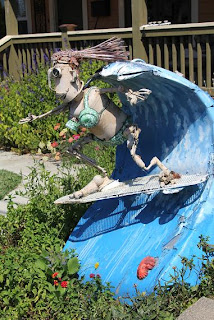Florence Street. Sebastopol, CA.
 On first glance, this street through a residential area looks like any one of a thousand streets through similar neighborhoods across America.
On first glance, this street through a residential area looks like any one of a thousand streets through similar neighborhoods across America. But Florence Street is unlike any of those thousand others. Inter-mingled with the flowers, trees, and even gardens are one couple's collection of...junk.
But Florence Street is unlike any of those thousand others. Inter-mingled with the flowers, trees, and even gardens are one couple's collection of...junk."In a unique outdoor art gallery, sculptor-in-residence Patrick Amiot has sprinkled the front lawns of this residential street with his colorful, oversize works of art made of scrap metal and recycled parts—wheels, wrenches, scissors. They’re all so playful and fun, it’s hard to pick a favorite (four of the examples identified here are shown in the next four photos):
 Batman (complete with his tool belt, made from a toaster, flashlight, grease gun, meat grinder and cell phone [below]), a New York Yankees pitcher,
Batman (complete with his tool belt, made from a toaster, flashlight, grease gun, meat grinder and cell phone [below]), a New York Yankees pitcher,
 a mermaid,
a mermaid,  a farmer with a cow in his pickup truck. Gawking at people’s front lawns feels odd at first, but then you realize that’s the whole point" (trazzler. com).
a farmer with a cow in his pickup truck. Gawking at people’s front lawns feels odd at first, but then you realize that’s the whole point" (trazzler. com).The wide array of larger-than-life, brightly colored figures has become synonymous with the must-see sites in Sebastopol.
Objects destined for the dump are integral to the junk-art sculptures created by Patrick Amiot and meticulously painted and brought to life by his wife, Brigitte Laurent.
 The Amiot residence and studio is clearly apparent by the abundance of sculptures on the front lawn waiting for homes. (Two of these sculptures are shown below.)
The Amiot residence and studio is clearly apparent by the abundance of sculptures on the front lawn waiting for homes. (Two of these sculptures are shown below.) 

 "A successful ceramicist, Amiot was looking for a new direction in life. 'I always had this desire to do things out of objects, but I just couldn't imagine making a living out of it. I still can't.
"A successful ceramicist, Amiot was looking for a new direction in life. 'I always had this desire to do things out of objects, but I just couldn't imagine making a living out of it. I still can't.  It's one of those things when you think of something but tell yourself,
It's one of those things when you think of something but tell yourself, 'This would just be too good to be true.'
"In the midst of his career upheaval, Amiot started making junk art
 for fun. He created and installed a giant fisherman made from a water heater in his front yard, and received an unexpected reaction--his neighbors wanted to see more. The rest, as they say, is history.
for fun. He created and installed a giant fisherman made from a water heater in his front yard, and received an unexpected reaction--his neighbors wanted to see more. The rest, as they say, is history.  "'The whole purpose of my work is to glorify these objects, because they have their own spirit,' Amiot enthuses.
"'The whole purpose of my work is to glorify these objects, because they have their own spirit,' Amiot enthuses. 'When a hubcap has traveled on a truck for millions of miles, and has seen the prairies in the winter and the hot summer asphalt, when it's done traveling with that truck and finds itself in the scrap yard and I find it,
 I kind of like to use that. This hubcap, or whatever piece of metal, from the day it was manufactured until now, has an important history. And I like to think the spirit of all these things lived incredible lives. If they could talk to you, they could tell amazing stories. That's something I don't want to hide" (Suzanne Daly at patrick amiot.com).
I kind of like to use that. This hubcap, or whatever piece of metal, from the day it was manufactured until now, has an important history. And I like to think the spirit of all these things lived incredible lives. If they could talk to you, they could tell amazing stories. That's something I don't want to hide" (Suzanne Daly at patrick amiot.com). "'I owe a lot to my neighbors, because they've offered me a gallery--prime real estate,' Amiot enthuses.
"'I owe a lot to my neighbors, because they've offered me a gallery--prime real estate,' Amiot enthuses.'It's so great because I have the pleasure of seeing my work and they enjoy having art and interaction with people coming off the street waving, smiling, people walking up and down'" (Michael Houghton, metroactive.com).
As I walked past the homes on the three block strip of Florence Avenue, I came to enjoy the mood of the community and decreased my feeling of prying into the residents' living areas.
 And finally, there was the "The Zucchini Brothers" sculpture--a ladder of three jugglers with Zs on their jerseys, standing on each other's shoulders. The piece was made from motorcycle gas tanks, old metal garbage cans and alarm clocks.
And finally, there was the "The Zucchini Brothers" sculpture--a ladder of three jugglers with Zs on their jerseys, standing on each other's shoulders. The piece was made from motorcycle gas tanks, old metal garbage cans and alarm clocks."Trash" does not seem to be an appropriate descriptive category for such community-building, visitor-enjoying street art as Mr. Amiot's.
No comments:
Post a Comment